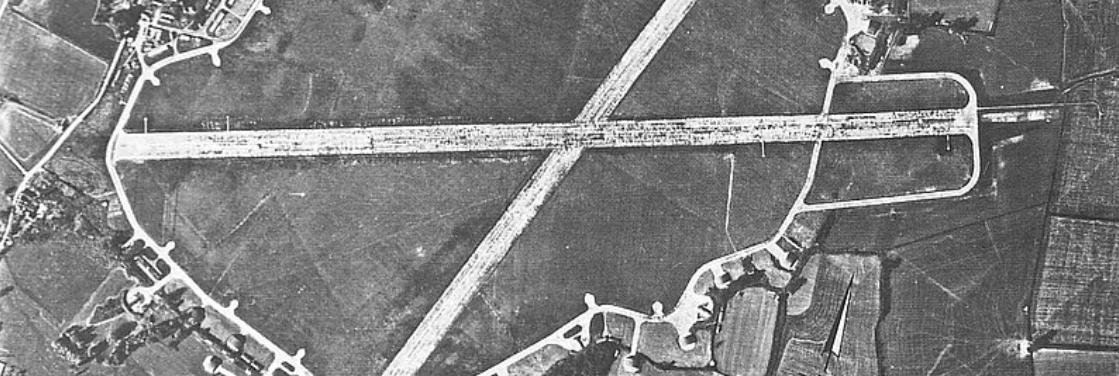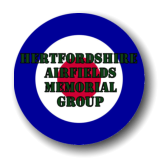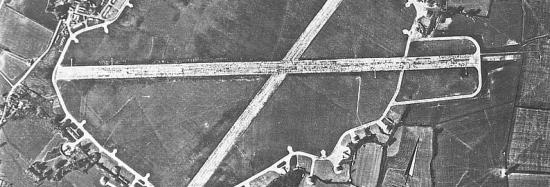Wartime Airfields

During
the
mid
1930's,
it
was
realised
by
the
Royal
Air
Force
that
it
needed
to
build
larger
and
better
equipped
airfields
if
another
War
with
Germany
was
going
to
be
a
distinct
possibility.
After
the
severe
cutbacks
of
the
1920's,
and
with
government
policy
being
not
to
fight
another
major
war
for
at
least
ten
years
it
would
be
a
large
expansion
indeed.
Many
purpose
built
airfields
were
established,
and
these
were
to
be
on
a
permanent
basis.
Built
with
brick
barrack
blocks,they
were
also
to
include
larger
aircraft
Hangars
for
servicing
and
maintenance,
comfortable
Officers
and
airmens
quarters
and
dining
halls,
in
fact
as
modern
as
could
be
imagined
at
the
time.
The
design
and
architecture
style
gave
the
impression
of
the
buildings
being
older than they were, benefiting from the ideas of one of the great architects of the time, Sir Edwin Landseer Lutyens OM, KCIE, FRA, FRIBA.
By
the
latter
part
of
the
decade,
it
was
becoming
obvious
that
even
more
airfields
would
be
needed.
After
many
potential
airfield
sites
were
surveyed,
a
period
of
increased
building
took
place
on
suitable
sites
with
agricultural
land
being
requisitioned
under
the
Emergency
Powers
Act
of
1939.
Landowners
and
Farmers
had
no
immediate
recompense,
nor
grounds
for
appeal,
and
many
did
not
get
their
land
back
until
long
after
the
war
was
over.
These
airfields
were
for
hostilities
only,
born
out
of
the
need
to
expand
quickly,
their
standard
of
build
was
not
at
all
like
the
large
airfields
mentioned
above.
Most
buildings
were
of
temporary
single
course
brick
construction
with
many
types
of
hutting
employed
to
serve
different
purposes,the
ubiquitous
curved
roof
Nissen,
pre-fabricated
Seco,
pre-cast
BCF,
Laing,
Janes
and
wooden
MOWP
were
among
the
many
types
employed.
Their
life
was
not
expected
to
be
that
long,
probably
ten
years
or
so.
The
level
of
luxury
at
these
airfields
was
non
existent.
Cold,
damp
with
sparse
heating
and
mud
everywhere,
an
airman
working
a
12
hour
shift
out
on
the
airfield
in
winter
finished
their
shift
cold
and
hungry.
They
then
managed
to
get
a
meal
at
the
communal
site
dining
hall,
with
probably
a
walk
up
to
a
mile
or
so,
to
a
sparse
hut
dripping
in
condensation,
rainwater
or
both It was no easy life on these temporary wartime airfields.
Much
evidence
can
be
found
of
these
temporary
airfields
and
their
former
existence,
But
alas,
with
each
year
that
passes
a
little
more
is
removed
forever,
until
one
day
nothing
will
remain.
For
their
four
or
five
years
of
operational
use,
these
type
of
airfields
were
home
to
thousands
of
air
and
ground
crews
from
all
over
the
world
including
Great
Britain,
the Commonwealth countries, and the United States of America.
After
the
war
was
over
they
were
abandoned,
and
quickly
fell
into
disrepair.
Many
of
the
buildings
were
removed
by
the
farmers
if
no
other
use
could
be
found
for
them
.
The
miles
of
concrete
from
the
perimeter
tracks
and
runways
was
lifted
and
sold
off
over
the
post
war
decades.
This
was
used
to
supply
the
hardcore-hungry
road
building
market
and
releasing
land
once
more
to
be
put
back
under
the
plough.
Even
today
more
and
more
old
airfields
are
being
grubbed
out for hardcore and crushed concrete. Now the current trend is to cover the face of what remains of these airfields with solar farms or wind turbines.
It
is
a
shame
to
see
these
once
proud
places
slowly
being
eradicated
from
the
British
landscape.
To
me
they
are
probably
just
as
important
a
part
of
England's
heritage
as
a
castle
or
an
old
battlefield.
For
in
reality,
battlefields
they
once
were.
An
army
of
personnel
manned
the
various
services
that
provided
the
support
to
make
them
functional
and,
of
course,
not
forgetting
the
aircrew
that
failed
to
return
from
the
missions
flown,
nor
ground
crew
involved
in
accidents
on
the
ground.
For
fast
turning
propellers
claimed
quite
a
few
personnel
at
many
airfields
while
working
in
close
proximity
to
the
aircraft themselves.
Most
have
almost
disappeared
from
sight
now.
In
most
cases
the
wide
runways
and
perimeter
tracks
are
just
mere
pathways
of
just
a
few
feet
wide.
From
the
air,
it
is
still
possible
to
'see'
the
outline
of
them,
but
not
everyone
has
the
chance
to
view
them
in
this
way.
So,
like
most
they
resort
to
foot
in
an
effort
to
explore.
A
few
still
have
their
huge
runways
and
perimeter
tracks
intact,
and
have
escaped
destruction,
but
they
are
rare
survivors.
This
website
features
just
three
of
those
temporary
airfields,
RAF
Hunsdon
and
RAF
Sawbridgeworth,
both
in
East
Hertfordshire,
and
the
USAAF
Station
161
at
Matching
Green
Essex.
This
airfield
was
built
by
the
Americans
themselves
for
the
US
Ninth
Air
force, and their twin engined B-26 Martin Marauder Bombers.
All three are near the Town of Harlow that is on the boundary of the two counties.
If
you
do
intend
to
see
for
yourself
the
remains
of
these
airfields,
try
to
adhere
to
a
few
basic
points.
Most
farmers
are
familiar
with
the
history
of
the
land
they
work,
and
many
will
understand
the
interest
generated
by
an
old
wartime
airfield,
the
last
thing
they
want
is
people
walking
through
crops,
or
grazing land for livestock. Use common sense when visiting any of the airfields listed here, or anywhere else.
Please
remember
that
these
airfields
are
located
on
someone’s
land.
If
you
do
plan
to
visit,
please
gain
permission
to
enter,
or,
alternatively,
use
any
public
rights
of
way
that
may
exist
across
these
former
airfields.
CLOSE
behind
you,
any
gates
that
you
open.
DO
NOT
drop
litter.
DO
NOT
park
your
vehicle blocking access to fields or farms, and please DO NOT attempt to drive across private land.
Denis Sharp, HAMG, Harlow, Essex, England.
In Memory of those who have helped us create the memorials, and who have passed away since :
Bunty Anderson. Ivor Harris. Keith Callaby. Fred Hitching. John Knight (HAMG Member), Dave Mead (HAMG Member)
Squadron Leader Tom Bennett DFM.
Roy Howe, Fred Sewell, both of whom were members of the Nazeing RAFA Assc. and who had supported us tirelessly.
Useful links
Online History of RAF Hunsdon, RAF Sawbridgeworth and the USAAF Bomber airfield at
Matching Green, Essex, England.
In association with the Hertfordshire Airfields Memorial Group.





Wartime Airfields
rjkdesign
Wartime Airfields
rjkdesign











Wartime Airfields

Online History of RAF Hunsdon, RAF
Sawbridgeworth and the USAAF Bomber airfield at
Matching Green, Essex, England.
In association with the Hertfordshire Airfields Memorial Group.
During
the
mid
1930's,
it
was
realised
by
the
Royal
Air
Force
that
it
needed
to
build
larger
and
better
equipped
airfields
if
another
War
with
Germany
was
going
to
be
a
distinct
possibility.
After
the
severe
cutbacks
of
the
1920's,
and
with
government
policy
being
not
to
fight
another
major
war
for
at
least
ten
years
it
would
be
a
large
expansion
indeed.
Many
purpose
built
airfields
were
established,
and
these
were
to
be
on
a
permanent
basis.
Built
with
brick
barrack
blocks,they
were
also
to
include
larger
aircraft
Hangars
for
servicing
and
maintenance,
comfortable
Officers
and
airmens
quarters
and
dining
halls,
in
fact
as
modern
as
could
be
imagined
at
the
time.
The
design
and
architecture
style
gave
the
impression
of
the
buildings
being
older
than
they
were,
benefiting
from
the
ideas
of
one
of
the
great
architects
of
the
time,
Sir
Edwin Landseer Lutyens OM, KCIE, FRA, FRIBA.
By
the
latter
part
of
the
decade,
it
was
becoming
obvious
that
even
more
airfields
would
be
needed.
After
many
potential
airfield
sites
were
surveyed,
a
period
of
increased
building
took
place
on
suitable
sites
with
agricultural
land
being
requisitioned
under
the
Emergency
Powers
Act
of
1939.
Landowners
and
Farmers
had
no
immediate
recompense,
nor
grounds
for
appeal,
and
many
did
not
get
their
land
back
until
long
after
the
war
was
over.
These
airfields
were
for
hostilities
only,
born
out
of
the
need
to
expand
quickly,
their
standard
of
build
was
not
at
all
like
the
large
airfields
mentioned
above.
Most
buildings
were
of
temporary
single
course
brick
construction
with
many
types
of
hutting
employed
to
serve
different
purposes,the
ubiquitous
curved
roof
Nissen,
pre-
fabricated
Seco,
pre-cast
BCF,
Laing,
Janes
and
wooden
MOWP
were
among
the
many
types
employed.
Their
life
was
not
expected
to
be
that
long,
probably
ten
years
or
so.
The
level
of
luxury
at
these
airfields
was
non
existent.
Cold,
damp
with
sparse
heating
and
mud
everywhere,
an
airman
working
a
12
hour
shift
out
on
the
airfield
in
winter
finished
their
shift
cold
and
hungry.
They
then
managed
to
get
a
meal
at
the
communal
site
dining
hall,
with
probably
a
walk
up
to
a
mile
or
so,
to
a
sparse
hut
dripping
in
condensation,
rainwater
or
both
It
was
no
easy
life on these temporary wartime airfields.
Much
evidence
can
be
found
of
these
temporary
airfields
and
their
former
existence,
But
alas,
with
each
year
that
passes
a
little
more
is
removed
forever,
until
one
day
nothing
will
remain.
For
their
four
or
five
years
of
operational
use,
these
type
of
airfields
were
home
to
thousands
of
air
and
ground
crews
from
all
over
the
world
including
Great
Britain,
the
Commonwealth countries, and the United States of America.
After
the
war
was
over
they
were
abandoned,
and
quickly
fell
into
disrepair.
Many
of
the
buildings
were
removed
by
the
farmers
if
no
other
use
could
be
found
for
them
.
The
miles
of
concrete
from
the
perimeter
tracks
and
runways
was
lifted
and
sold
off
over
the
post
war
decades.
This
was
used
to
supply
the
hardcore-hungry
road
building
market
and
releasing
land
once
more
to
be
put
back
under
the
plough.
Even
today
more
and
more
old
airfields
are
being
grubbed
out
for
hardcore
and
crushed
concrete.
Now
the
current
trend
is
to
cover
the
face of what remains of these airfields with solar farms or wind turbines.
It
is
a
shame
to
see
these
once
proud
places
slowly
being
eradicated
from
the
British
landscape.
To
me
they
are
probably
just
as
important
a
part
of
England's
heritage
as
a
castle
or
an
old
battlefield.
For
in
reality,
battlefields
they
once
were.
An
army
of
personnel
manned
the
various
services
that
provided
the
support
to
make
them
functional
and,
of
course,
not
forgetting
the
aircrew
that
failed
to
return
from
the
missions
flown,
nor
ground
crew
involved
in
accidents
on
the
ground.
For
fast
turning
propellers
claimed
quite
a
few
personnel
at
many
airfields
while
working in close proximity to the aircraft themselves.
Most
have
almost
disappeared
from
sight
now.
In
most
cases
the
wide
runways
and
perimeter
tracks
are
just
mere
pathways
of
just
a
few
feet
wide.
From
the
air,
it
is
still
possible
to
'see'
the
outline
of
them,
but
not
everyone
has
the
chance
to
view
them
in
this
way.
So,
like
most
they
resort
to
foot
in
an
effort
to
explore.
A
few
still
have
their
huge
runways
and
perimeter
tracks
intact,
and
have
escaped
destruction,
but
they
are
rare
survivors.
This
website
features
just
three
of
those
temporary
airfields,
RAF
Hunsdon
and
RAF
Sawbridgeworth,
both
in
East
Hertfordshire,
and
the
USAAF
Station
161
at
Matching
Green
Essex.
This
airfield
was
built
by
the
Americans
themselves
for
the
US
Ninth
Air
force,
and
their
twin
engined B-26 Martin Marauder Bombers.
All
three
are
near
the
Town
of
Harlow
that
is on the boundary of the two counties.
If
you
do
intend
to
see
for
yourself
the
remains
of
these
airfields,
try
to
adhere
to
a
few
basic
points.
Most
farmers
are
familiar
with
the
history
of
the
land
they
work,
and
many
will
understand
the
interest
generated
by
an
old
wartime
airfield,
the
last
thing
they
want
is
people
walking
through
crops,
or
grazing
land
for
livestock.
Use
common
sense
when
visiting any of the airfields listed here, or anywhere else.
Please
remember
that
these
airfields
are
located
on
someone’s
land.
If
you
do
plan
to
visit,
please
gain
permission
to
enter,
or,
alternatively,
use
any
public
rights
of
way
that
may
exist
across
these
former
airfields.
CLOSE
behind
you,
any
gates
that
you
open.
DO
NOT
drop
litter.
DO
NOT
park
your
vehicle
blocking
access
to
fields
or
farms,
and
please DO NOT attempt to drive across private land.
Denis Sharp, HAMG, Harlow, Essex, England.
In Memory of those who have helped us create the
memorials, and who have passed away since:
Bunty Anderson. Ivor Harris. Keith Callaby. Fred Hitching.
John Knight (HAMG Member), Dave Mead (HAMG Member)
Squadron Leader Tom Bennett DFM.
Roy Howe, Fred Sewell, both of whom were members of the Nazeing
RAFA Assc. and who had supported us tirelessly.





rjkdesign


rjkdesign
Wartime Airfields






b26.com is dedicated to Martin B-26 Marauder men
who fought in World War 2. Photos of crews and
planes, personal accounts, and related information.


Other Useful Links












